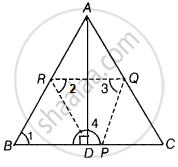Advertisements
Advertisements
प्रश्न
If P, Q and R are the mid-points of the sides BC, CA and AB of a triangle and AD is the perpendicular from A on BC, prove that P, Q, R and D are concyclic.
उत्तर

Given: In ΔABC, P, Q and R are the mid-points of the sides BC, CA and AB respectively. Also, AD ⊥ BC.
To prove: P, Q, R and D are concyclic.
Construction: Join DR, RQ and QP
Proof: In right-angled ΔADP, R is the mid-point of AB.
∴ RB = RD
⇒ ∠2 = ∠1 ...(i) [Angles opposite to the equal sides are equal]
Since, R and Q are the mid-points of AB and AC, then
RQ || BC ...[By mid-point theorem]
or RQ || BP
Since, QP || RB, then quadrilateral BPQR is a parallelogram.
⇒ ∠1 = ∠3 ...(ii) [Opposite angles of parallelogram are equal]
From equations (i) and (ii),
∠2 = ∠3
But ∠2 + ∠4 = 180° ...[Linear pair axiom]
∴ ∠3 + ∠4 = 180° ...[∴ ∠2 = ∠3]
Hence, quadrilateral PQRD is a cyclic quadrilateral.
So, points P, Q, R and D are non-cyclic.
Hence proved.
APPEARS IN
संबंधित प्रश्न
Let the vertex of an angle ABC be located outside a circle and let the sides of the angle intersect equal chords AD and CE with the circle. Prove that ∠ABC is equal to half the difference of the angles subtended by the chords AC and DE at the centre.
ABCD is a parallelogram. The circle through A, B and C intersect CD (produced if necessary) at E. Prove that AE = AD.
In any triangle ABC, if the angle bisector of ∠A and perpendicular bisector of BC intersect, prove that they intersect on the circumcircle of the triangle ABC.
ABCD is a cyclic quadrilateral in BC || AD, ∠ADC = 110° and ∠BAC = 50°. Find ∠DAC.
Prove that the perpendicular bisectors of the sides of a cyclic quadrilateral are concurrent.
ABCD is a cyclic quadrilateral in which BA and CD when produced meet in E and EA = ED. Prove that AD || BC .
In the given figure, ABCD is a cyclic quadrilateral in which ∠BAD = 75°, ∠ABD = 58° and ∠ADC = 77°, AC and BD intersect at P. Then, find ∠DPC.

In the given figure, ABCD is a quadrilateral inscribed in a circle with centre O. CD is produced to E such that ∠AED = 95° and ∠OBA = 30°. Find ∠OAC.

In a cyclic quadrilaterals ABCD, ∠A = 4x, ∠C = 2x the value of x is
If a line is drawn parallel to the base of an isosceles triangle to intersect its equal sides, prove that the quadrilateral so formed is cyclic.
